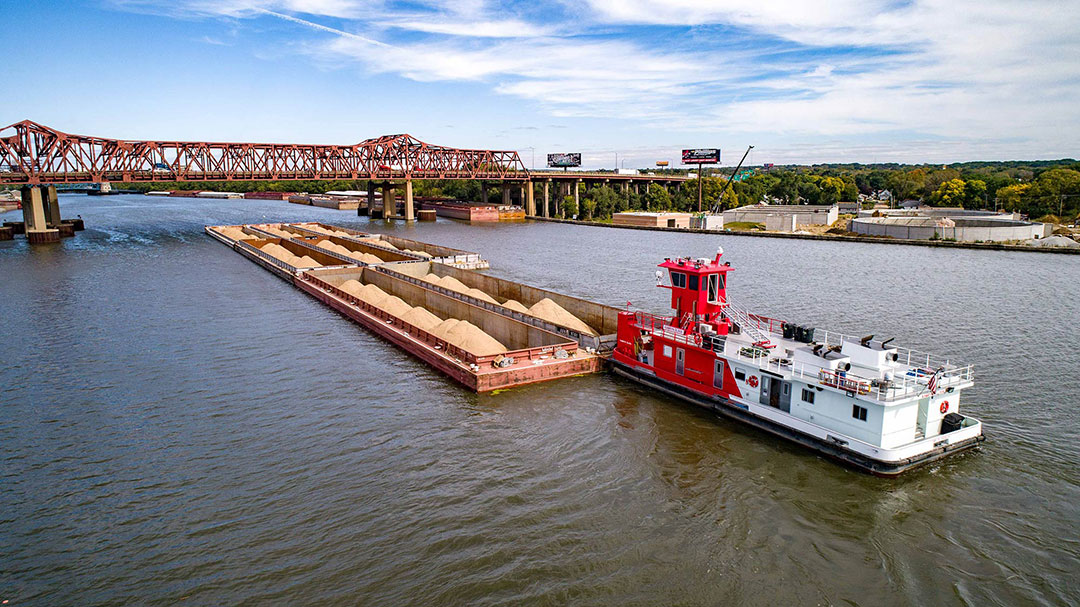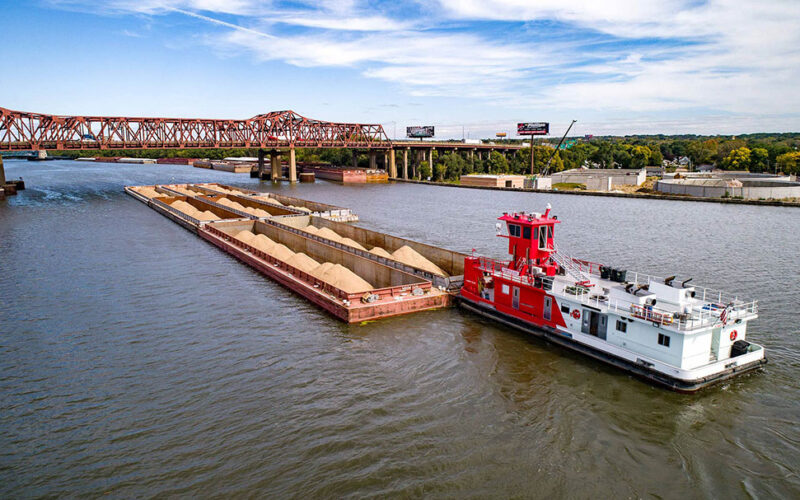
The nation’s inland waterway system is a sprawling 12,000-mile network of rivers that serves as a highway for commerce moving to and from 28 states.
Operations on those waters are much the same as they have been for generations – they operate with a fundamental consistency that has 630 million tons of products from soybeans and coal to aggregates and petrochemicals moving annually on barges year after year with seasonal weather patterns and winter layovers for necessary repairs factored into the mix.
Still, like the proverbial fiddler on the roof, some towing and barge industry leaders are apprehensive about recent developments and long-stewing issues – namely a deteriorating infrastructure, environmental mandates, and crew recruitment and retention – that, if not addressed effectively, could seriously impact the clockwork-like constancy that sets the tone for the operations of a transportation network of critical national importance.
Infrastructure and Adequate Maintenance
The state and age of infrastructure make for a perpetual concern for operators on the inland system where systematic inefficiencies can cause serious delays in the movement of waterway traffic.
A 2021 U.S. Army Corps of Engineers survey rated about a third of the country’s dam structures as being in “poor” or “unsatisfactory” condition. The same report found that more than 25 percent of all structures including dams, lock chambers, and flood risk management reservoirs – some of which date back to the era of Roosevelt’s New Deal – had “exceeded their estimated service lives.”
Fortunately, though, federal funding for inland waterways has increased with the 2021 infrastructure bill allocating $2.5 billion for improvements to the waterway system and its infrastructure.
“We have seen over the last ten fiscal years, increased funding for the Corps of Engineers (COE) to finish the work that they’ve started and begin new projects, as well,” according to Deb Calhoun, senior vice president of the Washington, D.C-based Waterways Council, calling the development “a very good sign.”
Now, though, some are realigning their focus to how that $2.5 billion is being used.
“Our efforts have been to ensure that all the money is faithfully spent,” said Rick Iuliucci, chairman of the American Waterways Operators (AWO), with the understanding that the COE has “a rather large work list and limited resources.”
Particularly important, he said, is the U.S. Coast Guard’s Waterways Commerce Cutter program, which calls for the construction of 30 new tenders to maintain more than 28,000 buoys and other pieces of navigational equipment on the waterway system. The new tenders would replace 35 older vessels currently in service. The Coast Guard has contracted with Birdon America of Denver, Co., to design the new craft.
The Coast Guard, said Iuliucci, “has been working with equipment which goes back to the ’50s, and we need those just as much as we need a [new] lock.”
Environmental Regulations and Industry Realities
Last fall, just as waterway operators were delivering seasonal grain harvests and rebounding from pandemic-related supply chain issues, a serious lack of rainfall in key areas caused a severe drop in water levels on the Mississippi River, a situation that resulted in the grounding of at least 30 barges and a virtual halt in traffic on the most critical artery in the entire waterway system.
According to Iuliucci of the AWO, the 1944 Flood Control Act allows for all parts of the Mississippi to be dredged by the Corps of Engineers to a depth of twelve feet to accommodate vessel traffic. But, he adds, COE dredgers have not always been able to maintain this depth on the lower parts of the river.
“One of the things we are advocating for, and have been since last year, is that, from Cairo down to Baton Rouge, to maintain a constant twelve-foot depth, so that we don’t have to deal with some of these adverse conditions,” he said.
But major arterial rivers like the Mississippi aren’t the only waterways that see their levels drop during times of sparse rainfall. Scores of smaller ports that dot the smaller ‘capillary’ rivers that connect with the larger are just as critical and have their own issues to deal with.
Topping that list is dredging, says the Waterways Council’s Deb Calhoun. “What the Engineers need is not only additional funding for dealing with hotspots as they occur from event to event, but additional funding to dredge out the smaller harbors.”
Also on the inland waterway’s plate of concerns is ascertaining the impact of waterway operations on the environment with industry leaders quick to point out that, because of the spatial capacity of barge tows, moving a ton of cargo by barge creates far fewer greenhouse emissions that moving that same ton by truck or rail.
For example, according to the Waterways Council, it would take 70 tractor trailer trucks or 16 railcars to move the 1,750 tons of cargo that could be moved via a single barge. Extrapolating even further, a single towboat with a 15-barge tow would carry the equivalent amount of cargo hauled by 16 locomotives hauling 216 railcars or 1,050 semi-tractor-trailers.
River shipping operators are not deaf to the need to reduce fuels like diesel and utilize new energy sources. Some European companies have fully electric-powered tows in the water and Houston’s Industrial Service Solutions plans to produce four such vessels for charter on U.S. waterways by 2025.
A 2021 report compiled by Vanderbilt University and the American Bureau of Shipping found that, “Electrifying larger river boats may not be feasible with current technology due to the size of batteries required but could potentially become achievable as battery technologies continue to evolve.”
The report concluded that electrifying smaller vessels was achievable in a practical sense and that biofuels acting as a so-called “drop in” fuel replacement are two ways to reduce the industry’s emissions footprint.
However, energy companies continue the challenging task of making emissions-reducing biofuels readily available at ports along the waterway network.
Some in the inland waterway sector fear regulations that would speed up a switch from diesel fuels before the industry has a reliable alternative fuel that packs the muscle of fossil fuel-burning engines.
“It’s just unfathomable that somebody can actually think [of] mandating the electrification of these massive cranes that are handling tons and tons,” said Aimee Andres, executive director of the St. Louis, Mo.-headquartered Inland Rivers, Ports and Terminals, Inc., a 300-member association of towboat and barge companies, terminal operators, shippers, equipment suppliers, and state and regional government agencies.
“The amount of energy that a diesel engine can provide versus the amount of wattage needed to operate an electrified machine aren’t close to comparable,” she said, adding that, “The conversations are happening on all levels of the government and, unfortunately, the government doesn’t understand how the supply chain works.”
Recruiting and Retaining Workers
The U.S. inland waterway system currently employs about 26,000 people, according to the U.S. Bureau of Labor Statistics. More than 20,000 of these jobs are in the category of transportation and material moving occupations and earn a mean salary of $92,700 a year.
Working on barges can generate a six-figure income earned without a college degree, yet the industry continues to worry about crew recruitment as post-COVID-19, U.S. workers increasingly value flexibility and work-life balance.
“We’re challenged because what we just saw following COVID was a higher emphasis on family life, especially for the young, strong labor that we’re trying to attract and recruit,” said Andres.
While a worthy societal goal, it creates a challenge for towboat operators that depend on a workforce that routinely spends extended periods of time working on the river.
The AWO’s Iuliucci said that operators are employing tactics the industry has never had to utilize before such as billboard advertising and staffing booths at job fairs. “For years and years, our industry never really had to try very hard to attract people because it was known that we have good paying jobs,” he said, adding that waterway jobs were very often passed through families as legacies. “The types of working relationships that we have with folks are starting to change,” he said.
One challenge is that the Coast Guard’s drug testing mandates date back to the 1980s. All vessel crew members who work in safety-sensitive positions are currently required to submit to standardized testing by labs that analyze urine specimens by utilizing tests that detect traces of cannabis weeks, or even months, after use.
It makes more sense for the shipping industry to use a saliva test that would show recent use, according to the AWO’s Iuliucci. The problem, he said, “is that the U.S. does not have commercial testing labs. The minimum requirement is to have a lab that you can send the sample to get that type of test.”

